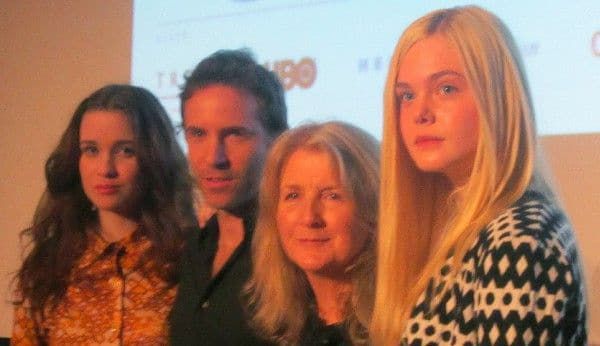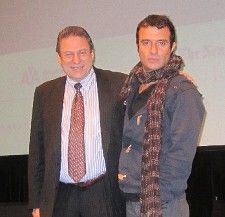 |
| Ginger And Rosa's Alice Englert (Rosa), Alessandro Nivola (Roland), director Sally Potter, Elle Fanning (Ginger) Photo: Anne-Katrin Titze |
Holy Motors

Holy Motors - which follows a man on his shadowy journey from one life to the next - gives thanks to Claire Denis, Georges Franju and Henry James. The last one might puzzle you, but after all, Carax's 1999 film Pola X was based on Herman Melville's Pierre: Or, The Ambiguities. Maybe it isn't the author at all, and the dedication goes to Henry James Ford, Mr "Motor Man." Let one of the most intriguing day trips into our eros and psyche begin!
Anne-Katrin Titze: Thank you for a wonderful film about life. I have a question about one of your end credit thanks. You include Henry James. Is that Henry James Ford, Mr Motorman, Henry James, the author, or a bit of both?
Leos Carax: I thank Henry James for the scene in the hotel room, that I stole from Portrait Of A Lady… This particular scene is the most beautiful scene ever written.
AKT: The character of Merde (one of Denis Lavant's 11 characters) seems to have a special connection with birds, I noticed. He is looking up, we hear the birds, very loudly, before he goes underground into the sewers, and also when he comes out. Is there anything you could tell us about that?
LC: It happens that in Tokyo (where the character originated in cinematic triptych Tokyo! in 2008) they have a lot of crows. When we were shooting he was looking at the crows, so we kept that for Holy Motors, whenever he was going underground.
Ginger And Rosa

In Ginger And Rosa - a story of two teenagers' friendship and betrayal in Sixties London - the girls (Elle Fanning and Alice Englert) take a bath in their skinny jeans to shrink them, while talking about Simone de Beauvoir. In matching duffle coats and turtlenecks they walk on the pebbles at a wintry shore.
AKT: I have a question about the style. The two girls have that uniform, I think it's something timeless, that many people can identify with: Dressing the same as your girlfriend. The only one whose style changes, I noticed, is Rosa, when she gets her hair cut, she gets bangs and that eyeliner, that makes her a mother.
Sally Potter: These were visual clues plotted very carefully. They were already in the script and then worked on with Holly Waddington, who designed the clothes, found the clothes often, and with Tara McDonald, who did the hair and makeup. We dropped the tiny, subtle visual clues of change, as markers, really, of the kinds of changes that were happening in the character. And [the girl's mother] Natalie, played by Christina (Hendricks) is another, somewhat butterfly-like character who defines who she is partly through different looks. The idea was, they start looking like twins, this kind of twinning feeling of best friends, that I certainly remember, when you wear the same clothes. And then, the trauma, when your friend suddenly wears a skirt and you're still wearing jeans.
AKT: Precisely.
Elle Fanning nods and gives me a big smile.
SP: These are signals. This wild transitioning between talking about God and politics, and then jeans, I remember as the intensity of teenage life.
Potter points to the "grand passion" of these early friendships, that can reach "the scope, the dimensions of a Greek tragedy."
The Dead Man And Being Happy

In Javier Rebollo's The Dead Man and Being Happy, Santos (José Sacristán), a hired killer, who possibly never killed anyone, is, true to Roland Barthes, a myth, who in his pyjamas has more dignity than many a businessman in a suit. He is on a very special road trip through a rapidly changing Argentina, where he encounters a German mountain colony, with many men of a certain old age, a beach between paradise and apocalypse, and his travel companion Erika (Roxana Blanco), whose father breeds dogs and who is on a journey of her own.
AKT: There is an archival quality to your film. You are showing certain places that will disappear soon. I was reminded, when you show the mall, for example, I was thinking of Walter Benjamin's unfinished Arcades Project. Snippets of places that are about to disappear.
Javier Rebollo It's great, that's great!
Just what you said was worth the trip to New York. A city which I didn't like for some personal reasons. Cézanne used to say, one has to paint very quickly, because places disappear very quickly. Bresson took that motto and also worked very quickly. To make a film is to make something of a piece of paper that's burning. All of those places are just on the point of about to disappear.
In my first film, we were filming in a provincial hospital. We were filming on the right side, and on the left side, they were knocking it down. All the area where we filmed has been knocked down after we made that film (Woman Without Piano, 2009). And with that, all the people who used to live there remain now only as phantoms, as traces. Of course, you can make other films there, but you can never make these films. Aki Kaurismäki, who is a friend, said, "We have to film those places, because by filming them, we are saving them". And in fact, the book that I brought with me, my reading material, was the book by Walter Benjamin about the Arcades. It's great you brought that up.





















